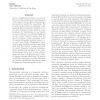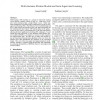17 search results - page 3 / 4 » Exponential families and simplification of mixture models |
ACL
1997
14 years 6 days ago
1997
This paper introduces new methods based on exponential families for modeling the correlations between words in text and speech. While previous work assumed the effects of word co-...
ICML
2005
IEEE
14 years 11 months ago
2005
IEEE
Given a classification problem, our goal is to find a low-dimensional linear transformation of the feature vectors which retains information needed to predict the class labels. We...
SDM
2011
SIAM
13 years 1 months ago
2011
SIAM
Multi-instance (MI) learning is a variant of supervised learning where labeled examples consist of bags (i.e. multi-sets) of feature vectors instead of just a single feature vecto...
ICML
2008
IEEE
14 years 11 months ago
2008
IEEE
We present a principled Bayesian framework for modeling partial memberships of data points to clusters. Unlike a standard mixture model which assumes that each data point belongs ...
JSC
2006
13 years 10 months ago
2006
In statistics, mixture models consisting of several component subpopulations are used widely to model data drawn from heterogeneous sources. In this paper, we consider maximum lik...


